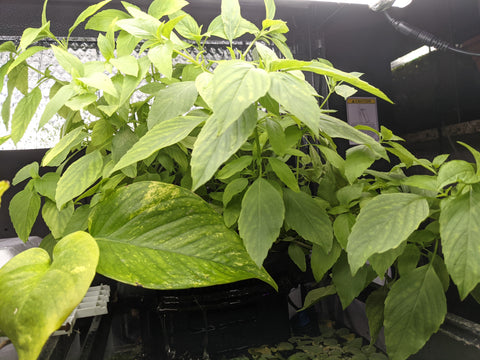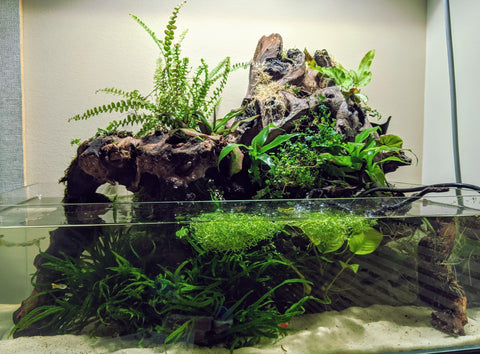(DISCLOSURE: This post may contain affiliate links. As an Amazon Associate, I earn from qualifying purchases. Read our full Affiliate Disclosure here.)
Using common house plants such as Pothos (Devil’s Ivy), Philodendrons, Lucky Bamboo, etc, is a great way to help keep your water clean and healthy, and to help lower nitrates. Just like aquatic plants, house plants also act as a “natural filter” by using the nutrients dissolved in your tank’s water to grow.
Table of content
Why Tank Water is Great for Plants
If you’re familiar with plants in general, NPK, derived from the chemical symbols Nitrogen (N), Phosphorus (P), and Potassium (K), are the three major macronutrients that almost all plants need in larger quantities compared to other plant nutrients.
As mentioned in my previous blog post, A Guide to Growing Healthy Aquarium Plants, poop from living creatures in your aquarium such as your fish or shrimp provides Phosphorus, in the form of Phosphates, and Nitrogen compounds such as Nitrate which are used by plants to build amino-acids, which are then converted into proteins which are the "building blocks" of plants. A well-stocked tank should be able to provide sufficient amounts of both for plants to grow.
Growing plants emersed allows them to be a lot more effective (in general) in “sucking up” the nutrients in the water, as they have access to higher amounts of CO2 in the air compared to their aquatic plant counterparts, which are limited to the amount of CO2 dissolved or injected into the water. The more efficient the plants are in growing, the cleaner your water.
Common House Plants That Can Be Used in An Aquariums
So now that I’ve discussed the benefits of using traditional house plants in an aquarium, which ones are the ones that can be used? Well, technically almost any house plant can be used in an aquarium setting, as long as it only has its roots or lower stem submerged in water. Bog plants are plants that grow in wetland areas, and are commonly grown around ponds, which include plants such as Lucky Bamboo (Dracaena Sanderiana), Syngoniums (also commonly called Arrowhead Plants), and Peace Lilies. Some popular house plants that many aquarists have used in their setups include:
- - Pothos Plants, or Devil’s Ivy (e.g. Golden Pothos, Marble Queen Pothos, Cebu Blue Pothos)
- - Philodendrons (e.g. Philodendron Brasil)
- - Tradescantia, or inch plants (e.g. Tradescantia Zebrina)
- - Spider plants
- - Monstera (e.g. Monstera Deliciosa, Monstera Adansonii)
- - Parlor Palm / Bella Palm
This list is not exhaustive, and I’ve personally found that many other plants such as the Aluminum Plant (Pilea cadieri), Hoyas (e.g. Hoya Krimson Queen, Hoya Krimson Princess), Aglaonema Chinese Evergreen Plants, and Thai Basil, can be grown emersed in an aquarium. It’s pretty much just aquaponics, and there is a large variety of plants that are suitable to be grown aquaponically. You could quite successfully start a mini herb garden, or veggie garden, using your aquarium as a source for water and nutrients to grow food! Many house plant hobbyists use water to propagate their house plants. It is relatively simple, and most plants can be propagated in water.
How To Plant Houseplants In Your Aquariums
1. HOB (Hang On the Back) Filters
The easiest and most common way is to grow them out of your hang-on-the-back filter. You can take the cover off and place the plant’s roots in the water, using your filter material as a bed for your plant.
You can also replace some of your filter media for LECA clay balls, a popular media used in hydroponics, which also helps increase surface area for beneficial bacteria to grow just like other aquarium filter media.
Recently, I came across the Elive Aqua-Duo Dual Purpose Aquarium Filter, which was specifically designed to allow you to grow plants out of the filter, and it even includes a bag of LECA clay balls!
I’ve been using it for about half a year now, and I’ve managed to grow Thai Basil seedlings into a massive full-grown bush with this filter! (NOTE: If it's out of stock on Amazon, you can try buying it on eBay instead!)

2. Plant Holders
These innovative plant holders are designed to be placed on the rim of the aquarium, so plants are able to receive plenty of light and their roots are able to grow immersed freely. They are easy to install and manage without disturbing the aquatic environment below, which is especially useful when performing routine maintenance.
They also come in different variations like these:
3. Fish Breeder Boxes
Acrylic Fish Breeder Boxes with Suction Cups can be used as a basket to hold media to plant your plants in. Hang on the back breeder boxes like the Fluval Hang On Breeder Box also is a great option if you don’t want to overcrowd your tank. It also comes in larger sizes with multi-chambers which can also double up as an extra mini sump.
4. Airline Tubing Suction Cups
Another way you can grow plants out of your aquarium is by using airline tubing suction cups. If the stem of the plant is thick enough, you can wedge it in between the grip. If not, you could also try using similar suction cups with zipties instead.

5. Glass Plant Cups
You can also use these glass plant cups that can be suction cupped to the wall of an aquarium and help keep the plant above water.
The video below is a great example on how to attach the glass plant cups to the wall of your aquarium. If you want, you can even add in some aquarium substrate into the cup to help weigh the plant down and prevent it from floating away!
6. Egg Crate
You can cut egg crate to fit the top of your aquarium using a wire cutter (to get a clean cut) and then place the egg crate on the top of the aquarium and allow the roots of a plant to dangle down into the water.

How To Propogate And Root House Plants In An Aquarium

- 1. Identify the location where you will snip your cutting from the main plant. Not all plants that can be rooted in water will have root nodes, but most of them do.
- 2. Make sure you sterilize your scissors before you use them. Carefully cut the stem just below the node, about ¼” below the node, with a clean sharp knife or scissors.
- 3. Submerge only the end of the cutting in your aquarium, making sure that the leaves are not underwater.
- 4. Usually, if you’re propagating a plant in water, you need to change the water in the container every other day to keep the water fresh and prevent the cutting from rotting. However, since the water in your aquarium is being filtered and oxygenated, it should be fine on its own and should start putting out roots within a few weeks usually.
Paludarium Style Tanks
Paludariums present a captivating fusion of terrestrial and aquatic environments, creating a lush ecosystem within a single enclosure. It’s been gaining popularity amongst the aquascaping community, with many incorporating terrestrial plants on top of the emersed section of wood and rocks, or forming a hill using aquarium substrate, allowing traditionally aquatic plants to transition to an emersed form as they grow past the water line. Paludariums offer a unique canvas for hobbyists to mimic the rich interplay between land and water found in nature, whilst pushing the boundaries of traditional aquascaping.
Below are some example pictures of beautifully set up paludariums:



There are many tutorials out there on how to set up a paludarium-type tank. SerpaDesign, a popular fish youtuber who is well known for incorporating terrestrial and aquatic elements together, has many videos on setting up paludarium and riparium style tanks. He recently posted a video on how he set up a riparium style aquascape during Aquashella in Chicago:
I hope after reading this, you’ll be inspired to start incorporating house plants into your aquarium setup! If you found this guide useful feel free to let me know in the comments!















3 thoughts on “A Guide To Growing House Plants In An Aquarium”
James bruce Shedden
Thank you. The information was perfect.
Jim
Shuvonkor Pramanik
This blog is really interesting! I didn’t know that regular house plants could be used in aquariums. The way you explained how plants help keep the water clean for the fish makes so much sense. I’m definitely going to try growing some plants in my aquarium now. Thanks for sharing this cool info!
Carol Mason
Are all those plants safe for fish in a pond?